 Identification
Identification
The Red-bellied Woodpecker is a long-billed, heavy-bodied woodpecker, between 9–10″ in length. The head has a red “mohawk” on a cream-colored face. The male’s red cap extends all the way from the forehead at the base of the bill to the back of the neck, while the female only has red on the back of the head. The Red-belly’s back is black with fine white barring with a matching pattern on the tail. The underparts are the same creamy color as the face. This woodpecker has a deeply undulating flight.
Red Belly?
With all the obvious red on the head where does the name Red-bellied Woodpecker come from? It comes from a time when birds were named from collected specimens. If you were to have a dead, or cooperative, Red-Bellied Woodpecker lying on a tray or in-hand you could much more easily spot the reddish wash on the lower underside of the bird.
Habits and Habitat
The Red-bellied Woodpecker is a year-round resident in wooded areas in the eastern half of the United States. This woodpecker has only been a Minnesota bird since the late 1800s, their range has expanded northward slowly over the years and continues to do so. Red-bellieds nest in cavities that both male and female help to excavate. Red-bellied Woodpeckers are very vocal birds. One will often hear their loud churr -ing call before the bird is seen.
Diet
Like other woodpeckers the Red-bellied spends a lot of time foraging for insects in or under tree bark, even during the winter. They will eat berries and tree nuts when they are available. Red-bellied Woodpeckers will frequent suet feeders and peanut feeders year-round. They’ll also eat sunflower seeds, Joe’s Mix or any sunflower seed mix from feeders.
Because of their larger bodies, Red-bellied Woodpeckers prefer larger suet feeders and a log suet feeder is a great way of drawing them to you yard.

